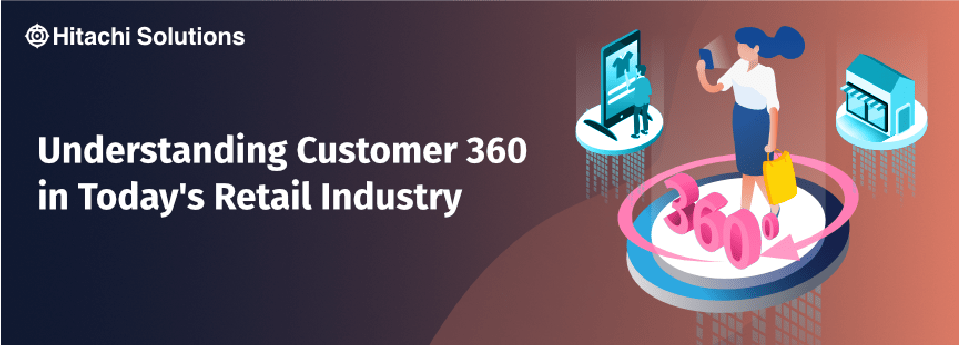

Retailers today that are looking to get a competitive edge know the key lies in providing the best customer experience possible. Consumers in the 21st century have high expectations as their options are endless and their needs and wants can be met instantaneously. So how do retailers gain insights on their target demographics and cater to every customer demand?
By having a full and comprehensive understanding of consumer trends and behavior.
This invaluable 360-degree view of each customer — now being called Customer 360 for short — enables retailers to leverage data and digital technologies to make smarter, data-driven business decisions. This umbrella concept of customer 360 can be put into practice with targeted initiatives that utilize the solutions made possible by retail digital transformation.
But what exactly is customer 360 and how can retailers put it into action?
What is Customer 360?
According to TechTarget, customer 360 is “the idea that companies can get a complete view of customers by aggregating data from the various touch points that a customer may use to contact a company to purchase products and receive service and support.”
In today’s omnichannel retail world, the number of touchpoints that connect retailers to their customers has multiplied drastically. Across ecommerce, in store, social media, and mobile apps, customers are constantly shopping, liking, saving, and favoriting – all of which leaves a trail for retailers to utilize.
Retailers have always been in pursuit of customer 360, long before the digital technologies of today. So, a modern 360 customer view is about taking all the data and information in a customer profile and using the latest AI and analytics systems to improve customer service, personalized service, and overall retail operations. When done correctly, customer 360 can lead to improved business outcomes and most importantly, revenue generation.
Data & Customer 360
In the world of the Internet of Things (IoT) and digital technologies like artificial intelligence (AI), machine learning, and big data, retailers have more information than they know what to do with. And customers are generating more and more data every second, which is beneficial in that it gives retailers a more complete profile, but problematic in that all of that data needs to be processed in order to be utilized.
To get a better idea of just how much data retailers are dealing with, here are just some of the metrics that can be collected and utilized by a retail customer relationship management (CRM) system:
- Demographics – name, age, address, contact information, occupation, place of employment, etc.
- Family information – children, partners, anniversaries
- Store information – preferred store, frequent purchases
- Social media – all social platforms, posts, likes, shares
- Behaviors – purchase triggers, purchase trends
- Marketing intel – lifetime sales, predicted lifetime value, average transaction, etc.
All of these datapoints are collected from the trail of information left by customers across social media, ecommerce sites, in store, and even in customer service interactions. Retailers use this information to build customer 360 views that enable them to provide the highest level of personalized service and build lifelong relationships and customer loyalty.
Applying Customer 360 to Your Operation
To be able to utilize data to create a 360-degree customer view, retailers must first ensure that all data is consolidated and accessible by one data analytics system. Years ago, it was commonplace to have disparate systems, but siloed data means inaccurate insights and an incomplete view of customer engagement.
When you have one complete data system that is aggregating as well as analyzing collected data, then retailers can build complete customer profiles and gain a 360-degree customer view. From there, it’s essential to deploy digital solutions – data analytics, machine learning, artificial intelligence, and a comprehensive retail CRM – to build a holistic customer profile and optimize customer engagement

Once customers have a robust profile, retailers can collect even more data from customer interactions, such as customer churn, segmentation, and product churn. Customer 360-powered solutions can then create a campaign performance dashboard that allows retailers to see how campaigns landed with different stores/customer segments.
So, what does all of this data and technology collaboration mean for retailers? It means retailers will be able to be more effective and targeted in everything they do, which pays dividends in the long run. In fact, 80% of customers are more likely to purchase a product or service from a brand who provides personalized experiences, according to an Epsilon study. Ultimately, customer 360 empowers retailers to optimize customer engagement, which translates into:
- Improved customer interaction
- More effective marketing campaigns
- New upsell/cross-sell opportunities
- More optimized customer strategies
Customer 360 all starts with an intelligent data analytics platform and a robust CRM system that allows retailers to leverage their insights. At Hitachi Solutions, we are experts in all retailer technologies, ranging from data aggregation and analytics to CRM and ERP applications. If you are ready to start putting your data to good use, contact our Hitachi retail team today.


